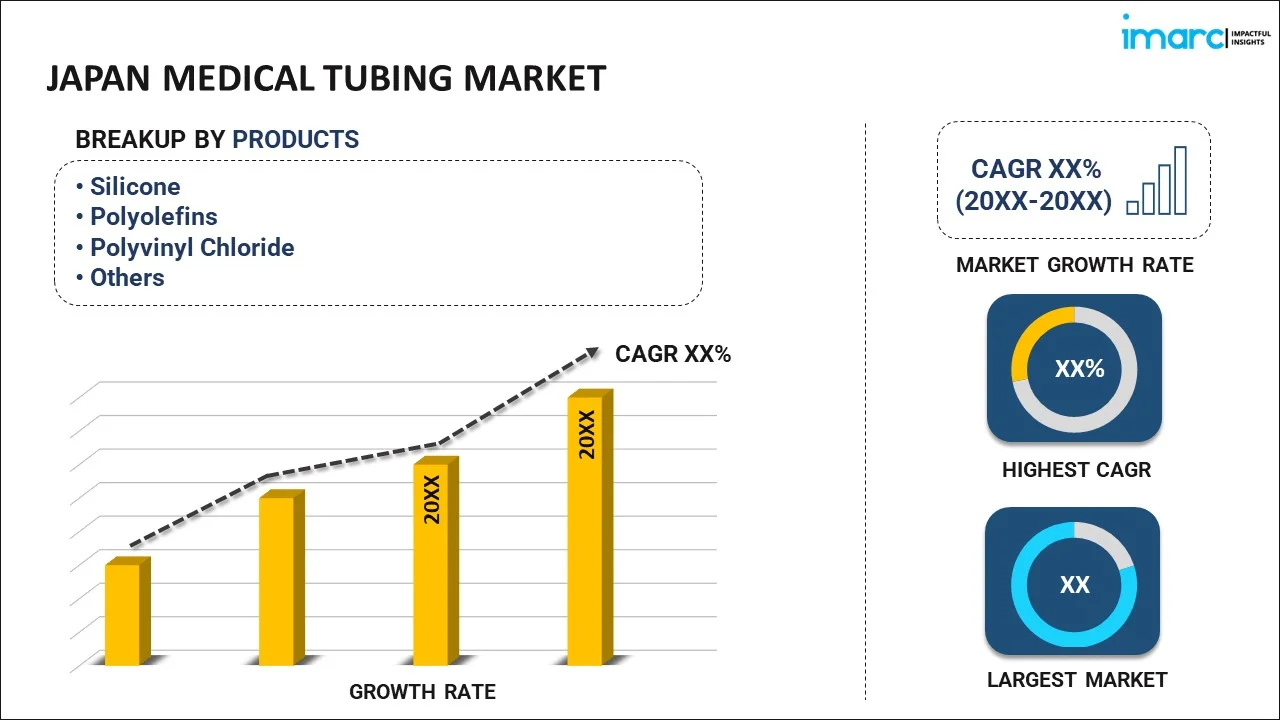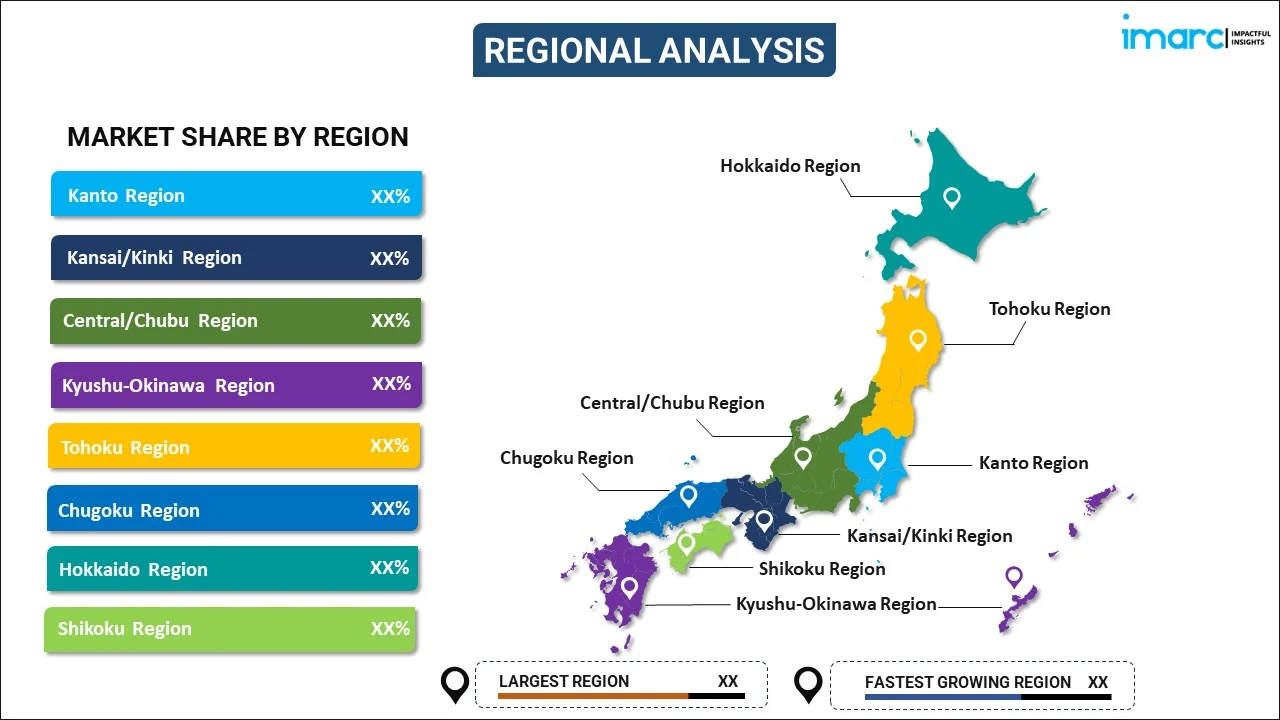
Japan Medical Tubing Market Report by Product (Silicone, Polyolefins, Polyvinyl Chloride, Polycarbonates, Fluoropolymers, and Others), Structure (Single-Lumen, Co-Extruded, Multi-Lumen, Tapered or Bump Tubing, Braided Tubing), Application (Bulk Disposable Tubing, Drug Delivery Systems, Catheters, Biopharmaceutical Laboratory Equipment, and Others), End User (Hospitals and Clinics, Ambulatory Surgical Centers, Medical Labs, and Others), and Region 2025-2033
Market Overview:
Japan medical tubing market size reached USD 507.5 Million in 2024. Looking forward, IMARC Group expects the market to reach USD 940.9 Million by 2033, exhibiting a growth rate (CAGR) of 6.4% during 2025-2033. The rising incidence of chronic diseases such as diabetes, respiratory disorders, and cardiovascular diseases, which necessitates the use of medical tubing in devices like insulin pumps, oxygen delivery systems, and stents, is driving the market.
|
Report Attribute
|
Key Statistics
|
|---|---|
|
Base Year
|
2024
|
|
Forecast Years
|
2025-2033
|
|
Historical Years
|
2019-2024
|
|
Market Size in 2024
|
USD 507.5 Million |
|
Market Forecast in 2033
|
USD 940.9 Million |
| Market Growth Rate 2025-2033 | 6.4% |
Medical tubing is a vital component in the healthcare industry, comprising flexible, hollow channels made from various materials like plastic, silicone, or rubber. These tubes serve a multitude of essential purposes, including the transport of fluids, gases, and even medications within a medical setting. They are commonly used in diverse applications such as intravenous (IV) lines, catheters, respiratory devices, and drainage systems. The choice of tubing material depends on factors like biocompatibility, flexibility, and durability. For example, silicone tubing is often preferred for its biocompatibility and resistance to high temperatures, while PVC tubing is suitable for fluid transfer due to its affordability and flexibility. Medical tubing undergoes rigorous quality control to ensure it meets safety and hygiene standards. Its sterile nature is crucial to prevent infections when used in invasive procedures. Innovations continue to emerge in medical tubing technology, aiming to enhance patient comfort, reduce infection risks, and improve overall medical care, making it an indispensable part of modern healthcare.
Japan Medical Tubing Market Trends:
The medical tubing market in Japan is experiencing robust growth due to several interconnected drivers. Firstly, the burgeoning regional population, combined with an aging demographic, has led to an increased demand for healthcare services and medical devices, thereby driving the need for medical tubing. Additionally, technological advancements in materials and manufacturing processes have allowed for the development of more advanced and customized medical tubing solutions, further propelling market growth. Moreover, the widespread adoption of various healthcare applications, such as ventilators and intravenous delivery systems, is leading to heightened demand, which has catalyzed innovation in the medical tubing sector, focusing on enhancing product performance, safety, and efficiency. Moreover, the rising prevalence of chronic diseases necessitates continuous monitoring and treatment, necessitating the use of medical tubing in applications like catheters and drug delivery systems. Apart from this, the inflating adoption of minimally invasive procedures and home healthcare setups to reduce costs and improve patient outcomes is expected to drive the medical tubing market in Japan during the forecast period.
Japan Medical Tubing Market Segmentation:
IMARC Group provides an analysis of the key trends in each segment of the market, along with forecasts at the country level for 2025-2033. Our report has categorized the market based on product, structure, application, and end user.
Product Insights:

- Silicone
- Polyolefins
- Polyvinyl Chloride
- Polycarbonates
- Fluoropolymers
- Others
The report has provided a detailed breakup and analysis of the market based on the product. This includes silicone, polyolefins, polyvinyl chloride, polycarbonates, fluoropolymers, and others.
Structure Insights:
- Single-Lumen
- Co-Extruded
- Multi-Lumen
- Tapered or Bump Tubing
- Braided Tubing
A detailed breakup and analysis of the market based on the structure have also been provided in the report. This includes single-lumen, co-extruded, multi-lumen, tapered or bump tubing, and braided tubing.
Application Insights:
- Bulk Disposable Tubing
- Drug Delivery Systems
- Catheters
- Biopharmaceutical Laboratory Equipment
- Others
The report has provided a detailed breakup and analysis of the market based on the application. This includes bulk disposable tubing, drug delivery systems, catheters, biopharmaceutical laboratory equipment, and others.
End User Insights:
- Hospitals and Clinics
- Ambulatory Surgical Centers
- Medical Labs
- Others
A detailed breakup and analysis of the market based on the end user have also been provided in the report. This includes hospitals and clinics, ambulatory surgical centers, medical labs, and others.
Regional Insights:

- Kanto Region
- Kansai/Kinki Region
- Central/ Chubu Region
- Kyushu-Okinawa Region
- Tohoku Region
- Chugoku Region
- Hokkaido Region
- Shikoku Region
The report has also provided a comprehensive analysis of all the major regional markets, which include Kanto Region, Kansai/Kinki Region, Central/ Chubu Region, Kyushu-Okinawa Region, Tohoku Region, Chugoku Region, Hokkaido Region, and Shikoku Region.
Competitive Landscape:
The market research report has also provided a comprehensive analysis of the competitive landscape. Competitive analysis such as market structure, key player positioning, top winning strategies, competitive dashboard, and company evaluation quadrant has been covered in the report. Also, detailed profiles of all major companies have been provided.
Japan Medical Tubing Market Report Coverage:
| Report Features | Details |
|---|---|
| Base Year of the Analysis | 2024 |
| Historical Period | 2019-2024 |
| Forecast Period | 2025-2033 |
| Units | Million USD |
| Scope of the Report | Exploration of Historical Trends and Market Outlook, Industry Catalysts and Challenges, Segment-Wise Historical and Future Market Assessment:
|
| Products Covered | Silicone, Polyolefins, Polyvinyl Chloride, Polycarbonates, Fluoropolymers, Others |
| Structures Covered | Single-Lumen, Co-Extruded, Multi-Lumen, Tapered or Bump Tubing, Braided Tubing |
| Applications Covered | Bulk Disposable Tubing, Drug Delivery Systems, Catheters, Biopharmaceutical Laboratory Equipment, Others |
| End Users Covered | Hospitals and Clinics, Ambulatory Surgical Centers, Medical Labs, Others |
| Regions Covered | Kanto Region, Kansai/Kinki Region, Central/ Chubu Region, Kyushu-Okinawa Region, Tohoku Region, Chugoku Region, Hokkaido Region, Shikoku Region |
| Customization Scope | 10% Free Customization |
| Post-Sale Analyst Support | 10-12 Weeks |
| Delivery Format | PDF and Excel through Email (We can also provide the editable version of the report in PPT/Word format on special request) |
Key Questions Answered in This Report:
- How has the Japan medical tubing market performed so far and how will it perform in the coming years?
- What has been the impact of COVID-19 on the Japan medical tubing market?
- What is the breakup of the Japan medical tubing market on the basis of product?
- What is the breakup of the Japan medical tubing market on the basis of structure?
- What is the breakup of the Japan medical tubing market on the basis of application?
- What is the breakup of the Japan medical tubing market on the basis of end user?
- What are the various stages in the value chain of the Japan medical tubing market?
- What are the key driving factors and challenges in the Japan medical tubing?
- What is the structure of the Japan medical tubing market and who are the key players?
- What is the degree of competition in the Japan medical tubing market?
Key Benefits for Stakeholders:
- IMARC’s industry report offers a comprehensive quantitative analysis of various market segments, historical and current market trends, market forecasts, and dynamics of the Japan medical tubing market from 2019-2033.
- The research report provides the latest information on the market drivers, challenges, and opportunities in the Japan medical tubing market.
- Porter's five forces analysis assist stakeholders in assessing the impact of new entrants, competitive rivalry, supplier power, buyer power, and the threat of substitution. It helps stakeholders to analyze the level of competition within the Japan medical tubing industry and its attractiveness.
- Competitive landscape allows stakeholders to understand their competitive environment and provides an insight into the current positions of key players in the market.
Need more help?
- Speak to our experienced analysts for insights on the current market scenarios.
- Include additional segments and countries to customize the report as per your requirement.
- Gain an unparalleled competitive advantage in your domain by understanding how to utilize the report and positively impacting your operations and revenue.
- For further assistance, please connect with our analysts.
 Inquire Before Buying
Inquire Before Buying
 Speak to an Analyst
Speak to an Analyst
 Request Brochure
Request Brochure
 Request Customization
Request Customization




.webp)




.webp)












